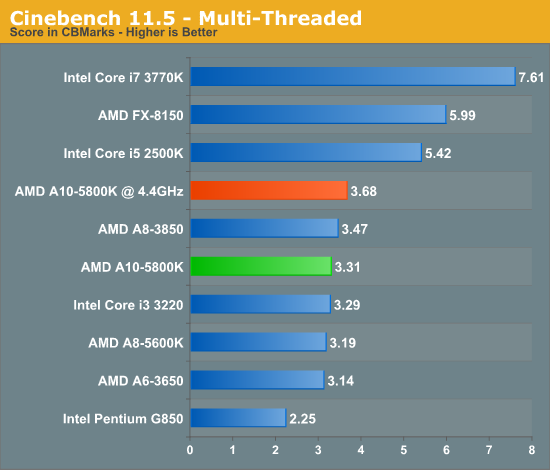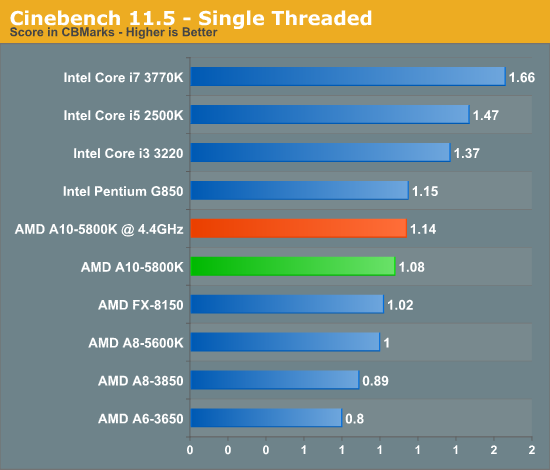AMD A10-5800K & A8-5600K Review: Trinity on the Desktop, Part 2
by Anand Lal Shimpi on October 2, 2012 1:45 AM ESTOverclocking
With Sandy Bridge Intel killed budget overclocking by completely clock locking all CPUs without turbo boost enabled. While you used to be able to buy an entry level CPU and overclock it quite nicely, Intel moved all overclocking to its higher priced parts. As a gift to the overclocking community, Intel ramped up the presence of its fully unlocked K-series parts. Anything with a K at the end shipped with a fully unlocked clock multiplier, at a small price premium. Given that Intel hadn't shipped unlocked CPUs since the days of the original Pentium, this was a welcome move on its part. What would really be nice is the addition of some lower priced K SKUs, unfortunatley we won't get that unless there's significant competitive pressure from AMD.
Trinity doesn't have what it takes to really force Intel into doing such a thing, but that doesn't mean AMD won't try. The Trinity lineup includes AMD's own K-series SKUs that, like their Intel counterparts, ship fully unlocked. From $67 all the way up to $122, AMD is offering unlocked Trinity APUs. The value of these parts really depends on just how overclockable Trinity is to begin with. The Bulldozer/Piledriver architecture is designed to push frequency, however AMD is already shipping these things at very close to 4GHz to begin with. Take AMD's turbo frequencies into account and you're already at 4.2GHz with the A10-5800K. How much additional headroom is there?

With a stock cooler and not a ton of additional voltage, it looks like there's another 5 - 15% depending on whether you're comparing base clocks or max turbo clocks. With an extra 0.125V (above the 1.45V standard core voltage setting) I was able to hit 4.4GHz on the A10-5800K. I could boot into Windows at 4.5GHz however the system wasn't stable. Although I could post at 4.6GHz, Windows was highly unstable at that frequency. With more exotic cooling I do believe I could probably make 4.5 work on the A10-5800K.

The extra frequency isn't enough to erase the single threaded performance gap between the A10 and Intel's Core i3 3220 however:

The only way AMD is going to close this gap is through a serious focus on improving single threaded performance in future architectures.










178 Comments
View All Comments
ditroia - Tuesday, October 2, 2012 - link
Hi Does anyone know what the highest end Radeon GPU I can use to Crossfire with the 7 Series GPU on the APU?Thanks in Advance
Dave
Roland00Address - Tuesday, October 2, 2012 - link
Cards you can do crossfire with the integrated graphics are as followsIf you buy itself
6450, 6570, 6670
If you get it prebuilt (these are the same gpus as above but they have a 1000 added to the number for that is what hp, dell, acer convinced amd to do for bigger numbers sell).
7450, 7570, 7670
That said you might want to do your research on asymmetric crossfire before hand, based on other websites reviews that tested it you are only going to get 30 to 60 percent scaling and the 7700 series cards are usually faster than the asymmetric crossfire.
ditroia - Tuesday, October 2, 2012 - link
Disappointing that you can't crossfire with a & series Discrete 7 series GPU, as I think that would have made a cheap but powerful Gaming system.Thanks
mikato - Wednesday, October 3, 2012 - link
Yeah I was really hoping to see a Crossfire with a lower end card as part of this review.Jamahl - Tuesday, October 2, 2012 - link
Llano vs the 2105 last year -http://www.anandtech.com/show/4476/amd-a83850-revi...
"Look at our single-threaded Cinebench scores below and you'll see a 50% performance advantage."
"CPU bound gaming performance is also an area where the A8 falls behind the i3. Here you're looking at a 25 - 50% advantage for the i3-2100/2105"
This is partly due to Ivy Bridge being so underwhelming.
The only problem I see is with load power which has gone backwards.
JKnows - Tuesday, October 2, 2012 - link
Video Drivers: AMD Catalyst 12.3 ???Are you kidding? That driver cannot even use Trinity architecture...
aislanluiz - Tuesday, October 2, 2012 - link
We’re power users, after all. We know how to cope with heat and noise; we can deal with a 100 W chip, even in an HTPC. But there’s no way to make the Core i3 look better unless you spring for an add-in card. AMD’s emphasis on balance makes the A10-5800K a better platform for more people than Intel’s closest competition.frozentundra123456 - Tuesday, October 2, 2012 - link
Trinity may be attractive for HTPC, but I cannot imagine a "power user" who does not have a discrete card in a desktop, at least if you are at all into gaming. The igpus are pathetic for gaming and you get better performance with intel plus discrete card.ericore - Tuesday, October 2, 2012 - link
I don't think Anand has a single benchmark that uses an App from AMD appStore. Even Tom's hardware was considerate enough to use Adobe CS6 products. I'm sorry but this benchmark makes Intel look better than it does. The benchmark is fully Intel optimized, System Max is Intel Optimized, no a single benchmark is AMD optimized. Disappointed Anand.The following review is much more fair:
http://www.tomshardware.com/reviews/a10-5800k-a8-5...
Beenthere - Tuesday, October 2, 2012 - link
The haters won't be happy but it's great that AMD has delivered as promised with Trinity desktop in addition to laptop. Trinity desktop delivers performance and value for those looking for an all-in-one solution at an extremely affordable price - which is a growing segment of the market as people discover the huge cost savings compared to a discrete CPU/GPU set-up. BTW, no one would ever consider Intel 2500 graphics as being usable, so the Trinity desktop APUs are literally in a class of their own for now.It's also worth noting that single thread performance is not the holy grail. Most people running modern software will be perfectly happy with Trinity desktop performance even if you crunch numbers now and then. Price and performance wise AMD has delivered a winning solution when you look at performance vs. cost. This will force Intel to discount it's i3/i5 products, which is good for all.
Obviously Trinity desktop is NOT intended as a replacement for a highend discrete CPU/GPU system. That will come in a few more years but for now AMD continues to offer excellent performance and value, which is what mainstream consumers desire.